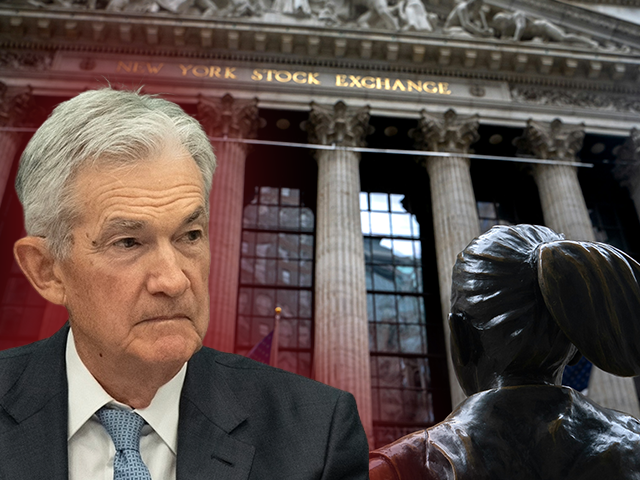Wall Street Is Fighting the Fed Again
Jerome Powell is hurtling toward what might be the biggest showdown of his career at the Federal Reserve.
The Fed chairman has repeatedly said that he views the risks to the economy as roughly balanced right now. If Fed policy stays tight for too long, it could needlessly raise unemployment and perhaps throw the economy into a recession. If it loosens too early, it risks kindling a new inflationary episode.
During a question-and-answer session in Washington on Monday, Powell noted that inflation and economic activity had slowed broadly in line with what Fed officials expected. We know from the June projections of Fed officials that if the economy develops as the Fed expects, they expect a single rate cut by the end of the year.
The market, however, has once again raced ahead of the Fed. The federal funds futures market now implies a near certainty—a 98 percent chance—that the Fed cuts at its September meeting and then over a 90 percent chance that it cuts again in either November or December. Indeed, there’s a better-than-even chance implied by the market that the Fed cuts at all three of those meetings.
The Rate Won’t Drop Until Consumers Won’t Shop
If this confidence in coming rate cuts seemed excessive on Monday, today it borders on absurd. The retail sales figures released by the Commerce Department today were much stronger than expected, and the May numbers were also unexpectedly revised up. Sales in the retail control group, which feeds into calculations of economic growth, rose 0.9 percent, following May’s 0.4 percent gain.
Compared with a year ago, overall retail sales are up 2.3 percent. Excluding autos and gas stations, retail sales are up 3.8 percent from a year ago. If we just look at year-to-date sales excluding autos and gas stations, we see a 3.6 percent rise from the first six months of last year.
Keep in mind that most retail sales are sales of goods—and goods pricing have been deflating slightly. Overall goods prices are down 0.4 percent over the past 12 months. Excluding food, energy, and used cars, goods prices are down 0.7 percent. What this means is that we’re seeing a real increase in core retail sales of something like 4.5 percent.

(Photo: freestocks/Unsplash)
That’s not the kind of economic growth that invites a cut from the Fed. To the contrary, it suggests that consumer spending is proving resilient to current interest rate levels and a somewhat cooler labor market. That raises the risk that inflation could once again increase or at least stop falling toward the Fed’s two percent target.
The Atlanta Fed’s GDPNow measure is showing a second quarter real growth rate of 2.5 percent, up from last week’s estimate of two percent. That would be a big increase in the rate of economic growth from the fourth quarter. Should the Fed really cut right after the economy visibly accelerates above what the central bank sees as its long-term potential?
When Will the Fed Push Back?
Given this, it’s natural to wonder why investors and analysts have talked themselves into the view that the Fed is going to cut multiple times in the second half of this year. The best explanation is that many market participants analyze Fed policy through a “real rates” lens and conclude that the Fed is undesirably tightening merely by keeping rates steady when inflation is falling.
A very clear example of this thinking came from Austan Goolsbee, the president of the Chicago Fed, in an interview this week.
“We are tightening,” Goolsbee told the Wall Street Journal. “We set this rate when inflation was over 4%, and inflation is now, let’s call it, 2.5%. That implies we have tightened a lot since we’ve been holding at this rate.”

Federal Reserve Bank of Chicago President Austan D. Goolsbee participates in the Federal Open Market Committee (FOMC) meeting on January 30-31, 2024. (Federal Reserve via Flickr)
The problem with this view is that the Fed’s interest rate target is only part of the tightness picture when it comes to monetary and financial conditions. The stock market rising to new record highs—for example—loosens financial conditions, offsetting some of the tightening. The Chicago Fed’s national financial conditions index recently fell to a score of -0.53, which is slightly looser than the average in the decade before the pandemic. So, conditions are not tight even if the real rate has crept upward.
The Fed faces a dilemma. It can either capitulate to the bond market or it can risk a market shock by pushing back against the market’s view. Traditionally, the Fed has been reluctant to disappoint the market when it has let expectations become as one-sided as they are now. But earlier this year, Powell pushed the market off the view of first quarter cuts and expectations for five cuts this year by signaling at the January Federal Open Market Committee (FOMC) meeting that no rate cut would be coming at the March meeting.
If Powell wants to repeat that, the Fed would signal at this month’s FOMC meeting that it does not expect to cut rates until the fourth quarter. That would likely cause some disruption as investors have to reset their bets, but it would give markets time to adjust.

COMMENTS
Please let us know if you're having issues with commenting.